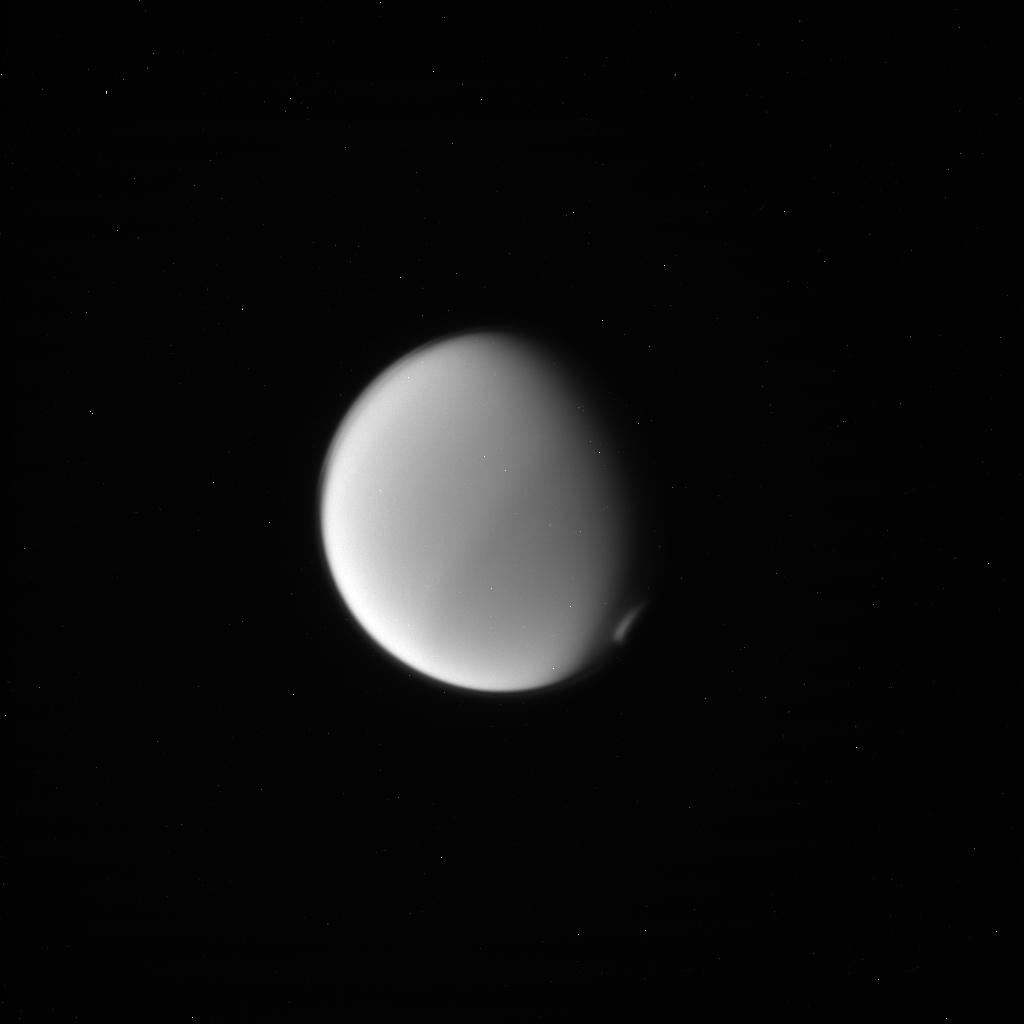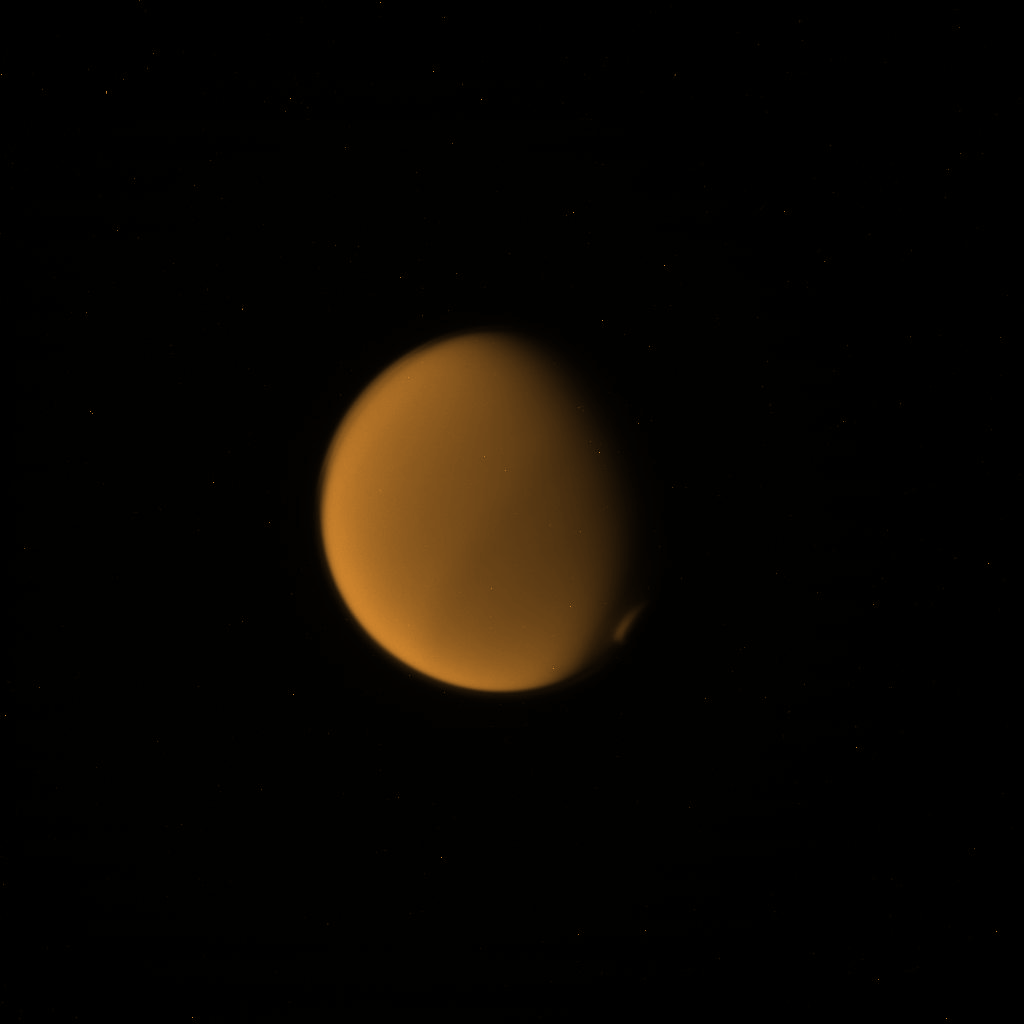March 26, 2020 : A New Research Work Suggests That LUVOIR-A May Allow Us To Identify Exoplanets Unveiling A Titan-Like Atmosphere
A new research work entitled « Study of Barnard's Star B as an Analog for 'Titan-like' Exoplanets » and proposed by a team involving R. Felton was presented at the 235th meeting of the American Astronomical Society in January 2020. The new study suggests that a space-based telescope like LUVOIR-A may allow us to study the characteristics of the atmosphere of an exoplanet like Barnard's Star b, an exoplanet which evolves around Barnard's Star, one of the nearest stars to the Sun. Barnard's Star represents a Red Dwarf located approximately 6 light-years away from us. Barnard's Star is part of the same category of stars as Proxima Centauri for instance. Those stars are less warm than our star which implies that the Habitable Zone will appear closer to the star. Researchers easily imagine worlds that look like Titan to a certain extent around a Red Dwarf like Barnard's Star. The particular characteristics of Titan's atmosphere can tell us a lot regarding the potential worlds we could encounter beyond the Solar System. The relatively big icy worlds or Terrestrial worlds are likely to contain an opaque atmosphere like the atmosphere of Venus or the atmosphere of Titan.
The mass of the exoplanet Barnard's Star b or Barnard b may represent at least 3.2 times the mass of the Earth. The relatively big extrasolar planet may evolve near the snow line of the relatively small star. Astronomers will have to confirm that outcome which is based on recent radial velocity measurements. On the basis of the apparent periodical movement of the star, one can deduce the presence of an exoplanet around it due to the gravitational interactions in the system. The researchers of the study believe that Barnard b is a rocky planet like the Earth or Venus and that it is covered in a thick atmosphere that may look like the atmosphere of Saturn's largest moon Titan. The planetologists know the surface temperature of the star. Therefore, they can infer the potential environmental temperature of any world at a particular distance from the star. If the exoplanet is larger than the Earth and much smaller than Neptune or Uranus, one can assume that the exoplanet may be a rocky world or an icy world. In the Outer Solar System, the atmospheres tend to be relatively rich in methane. That's the case for the deep and opaque atmosphere of Titan. That's also the case for Neptune or Uranus.
At the level of the orbit of Titan around the Sun, hydrocarbons like methane and ethane can appear in their liquid form on the surface of a world containing a sufficiently thick atmosphere because the environmental temperature is low enough for those molecules to remain liquid on the surface and to engender lakes, seas or even oceans. Barnard b is probably a rocky world where methane and ethane can appear in their liquid form on the surface. The giant moon of Saturn demonstrates that exotic meteorological cycles which are not based on water can take shape around other stars. The types of worlds encountered in the Solar System may be a relatively small sample of the various worlds encountered in the Universe. Titan unveils a meteorological cycle involving methane. In the environment of the Opaque Moon, one can observe lakes, seas, rivers, clouds, cyclones or vortices and one can identify evaporation processes, precipitation processes and condensation processes like on Earth. A parallel can be drawn between the water cycle of the Earth and the methane cycle of Titan. However, the meteorological configuration of Titan is, to a certain extent, very different from the meteorological configuration of the Earth.
If the moon or the planetary body is relatively far away from the star, water will appear in its frozen state on the surface. That's the case for Titan where environmental temperatures can be as low as about minus 180 degrees Celsius, minus 292 degrees Fahrenheit or 93 Kelvin. Titan represents a type of world that may be widespread in the Universe because methane is widespread in the Outer Solar System. The surface of Pluto is relatively rich in methane or organics for instance. Titan's atmosphere is dominated by molecular nitrogen but it also contains a relatively significant fraction of methane. The snow line is much closer to the star around a Red Dwarf than around a star similar to the Sun in terms of surface temperature or size. Barnard b may contain water ice on its surface and may be dominated by a meteorological cycle involving methane. Obviously, many factors must be taken into account. If the gravity is relatively high and if the environmental temperature is relatively low, the atmosphere may be particularly thick or heavy implying, potentially, relatively significant greenhouse effects. Venus is the perfect example of a world where greenhouse effects are remarkably high.
Planetologists have been in a position to determine that Titan's atmosphere can engender complex hydrocarbons or complex organics that can fall toward the surface to form a type of brown or red mud or sludge. Carl Sagan had developed the concept of tholin which represents that type of mud or sludge and which may be widespread beyond Jupiter or Saturn, in the Kuiper Belt or farther. The UV light from the Sun plays a key role in the exotic chemistry of Saturn's largest moon. The haze of Titan is rich in hydrocarbons and organics that can be engendered in the soup of ions, elements or compounds encountered in the upper atmosphere under the influence of ultraviolet light from the Sun. Heavier molecules tend to go down. The linear and parallel dunes found in the dark areas of the low or mid-latitudes may be the outcome of the organics or hydrocarbons generated in the haze or in the upper atmosphere. The study of Titan can allow us to better understand or to correctly analyze the spectrum of other cold worlds around other stars. Soon, thanks to the new advances in technologies, we may be in a position to characterize the atmosphere of the presumed exoplanet Barnard b.
The systems of Proxima Centauri, Alpha Centauri A, Alpha Centauri B and Barnard's Star are relatively close to the Sun so that one can envisage a satisfactory characterization of the various exoplanets evolving around those stars. Proxima b may look like the Earth and Barnard's Star b may look like Titan to a certain extent. The team of R. Felton has shown that a large space-based telescope like LUVOIR-A can bring us remarkable images of Barnard b. The researchers performed some simulations of the observation of Titan's features in a configuration in which Titan is an exoplanet. The planetologists mobilized the known properties of Barnard b as well as the performance of LUVOIR's coronagraph (ECLIPS). The simulations were performed on the basis of the Planetary Spectrum Generator (PSG) to generate synthetic reflectance spectrum of an exoplanet which has some characteristics of Barnard b and Titan. The first step was to reflect on the methodology to validate the Planetary Spectrum Generator against previous observations of Saturn's largest moon for transit and reflection spectroscopy. The planetologists also discussed some of the problems related to the validation process and how they were reduced.
In the second phase, the researchers unveiled simulations for Barnard b. They revealed the observable features of the exoplanet as well as top-level conclusions they were in a position to produce on the basis of the simulated observations. More recently, the team raised the level of complexity of the simulated atmosphere by incorporating typical hydrocarbons encountered in the atmosphere of the Opaque Moon. The outcome was included into the research work. The group showed which gases can be identified in the spectra. The researchers pointed out that there are uncertainties regarding the radius or the diameter of Barnard b and that those figures can have a major impact on the conclusions. The outcome of the research work demonstrates that exoplanets which look like Titan to a certain extent are characterizable by mobilizing a big space-based telescope. The next purpose of the researchers will be to analyze a larger range of planetary properties such as the size of the exoplanet, the chemical composition of the exoplanet or the semi-major axis of the orbit around the star.
Thanks to planetary exploration in the Solar System, we have been in a position to notice that our type of environment dominated by liquid water is rare. However, the Earth is not the only world where there are pools of stable liquids on the surface. Thanks to the Cassini-Huygens mission, we have been in a position to determine that Titan also contains pools of stable liquids. Methane can appear as a solvent like water does on Earth. Meteorology can imply other compounds than water. On the basis of what we see on Titan or on the Earth, one can deduce the potential properties of other worlds around other stars on the basis of the orbital or physical parameters we obtain. Today, we have a limited information regarding the presumed exoplanets Proxima b and Barnard b but the simulations allow us to infer the potential properties of the exoplanet or to simply speculate upon the potential characteristics of any exoplanet. The technology in terms of imaging is improving and new giant telescopes will emerge in the coming years or decades. One can easily imagine that we will collect, soon, key data regarding the composition or the dynamics of the atmosphere of exoplanets like Proxima b or Barnard b.
- To get further information on that news, go to: https://www.aas.org/sites/default/files/2020-01/AAS235-Meeting-Abstracts.pdf.

